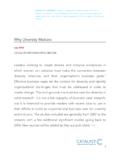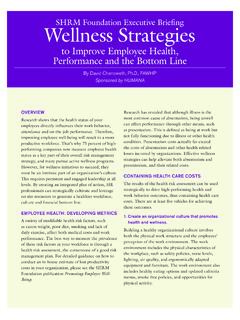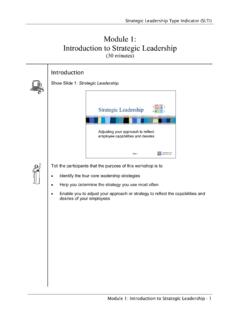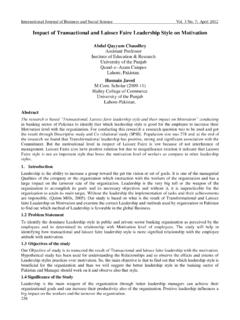Transcription of GETTING REAL ABOUT INCLUSIVE LEADERSHIP - Catalyst
1 GETTING real . ABOUT INCLUSIVE . LEADERSHIP . WHY CHANGE. STARTS WITH YOU. DNIKA J. TRAVIS, PHD. EMILY SHAFFER, PHD. JENNIFER THORPE-MOSCON, PHD. Managers Have the Power and Responsibility to Lead With Inclusion LEADING. You feel stuck leading your team unsure of the best approach to OUTWARD. help people take more ownership of their work. What you do to ensure Everyone you work with is geographically dispersed, and you team members are treated are GETTING feedback that people are not trusted to make their fairly, empowered, and own decisions. able to flourish. Your team members fear making mistakes and while you don't want to admit it, so do you. Since you're on the hook to show measurable progress for your LEADING. company's inclusion and diversity goals, you feel mounting INWARD. pressure to get it right or to fix it. Requires a hard look at who you are and your inner ability to act courageously, learn, and self-reflect.
2 As a people manager, you've probably faced one or more of these dilemmas. And while you may be confident in your ability to deliver on business goals, creating a cohesive team where everyone is excited to contribute and innovate can be more challenging. Building an INCLUSIVE team culture is key. We surveyed over 2,100 employees at large corporations most of whom worked in one of 8 countries to look deeply at predictors of inclusion. Our findings show that a manager's behavior has a direct link to an employee 's experience of inclusion in fact, almost half of an employee 's experience of inclusion can be explained by managerial INCLUSIVE LEADERSHIP And what are the manager behaviors that predict inclusion? We tested that, too and we uncovered2 a model of INCLUSIVE leadership3 that balances both leading outward and leading inward. Leading outward is what you do to ensure team members are treated fairly, empowered, and able to flourish.
3 Leading inward requires a hard look at who you are and your inner ability to act courageously, learn, and self-reflect. GETTING real ABOUT INCLUSIVE LEADERSHIP : WHY CHANGE STARTS WITH YOU | 2. We found that managers who practice both leading outward and leading inward can boost employee experiences of being valued, authentic, trusted, and psychologically safe at work the hallmarks of an INCLUSIVE Crucially, these experiences benefit employees and companies in tangible ways increasing team problem-solving, 5 employee engagement, 6 retention,7 and employee innovation. 8. So let's get real . You as a manager have the power and responsibility to lead with inclusion and reap the benefits for both your business and your team members. Start by understanding the six core LEADERSHIP behaviors and how they are connected to employee inclusion. LEADING OUTWARD LEADING INWARD. ACCOUNTABILITY CURIOSITY. OWNERSHIP HUMILITY.
4 ALLYSHIP COURAGE. PREDICTS AN INCLUSIVE WORKPLACE. Valued Trusted Authentic Psychological Psychological Safety: Safety: Latitude Risk-Taking GETTING real ABOUT INCLUSIVE LEADERSHIP : WHY CHANGE STARTS WITH YOU | 3. Key Findings Catalyst 's INCLUSIVE LEADERSHIP model powerfully predicts inclusion POSITIVE. among employees in a diverse cross-section of countries and populations. EXPERIENCES. o 45% of employee experiences of inclusion are explained by their OF INCLUSION. managers' INCLUSIVE LEADERSHIP behaviors. BENEFIT BOTH. Our model features two complementary dimensions and six core EMPLOYEES AND. behaviors. EMPLOYERS. o Leading outward accountability, ownership, allyship. o Leading inward curiosity, humility, courage. Many respondents report often or always having a positive experience of inclusion at work, but a large percentage do not highlighting an opportunity for managers to improve their own INCLUSIVE LEADERSHIP skills.
5 Positive experiences of inclusion benefit both employees and These experiences of inclusion explain: o 49% of team problem-solving. o 35% of work engagement. o 20% of intent to stay. o 18% of employee innovation. GETTING real ABOUT INCLUSIVE LEADERSHIP : WHY CHANGE STARTS WITH YOU | 4. ABOUT THIS STUDY. This study draws from quantitative data collected through the Catalyst Inclusion Accelerator . a diagnostic tool that evaluates and monitors how employees and teams experience inclusion. It includes survey results from 2,164 employees10 from 15 global companies in mostly eight countries. GENDER SEXUAL ORIENTATION. 50% <1% 90% 3%. Women Non-binary/ Do not Identify as Gender-fluid/ identify as lesbian, gay, 47% Third gender/ lesbian, gay, bisexual, queer, Men Trans spectrum bisexual, or asexual 3% <1% queer, or 7%. Prefer not Prefer to asexual Prefer not to say self-describe to say ETHNICITY11 AGE. 72% 28%.
6 Identify identify as a as white member of an 43. underrepresented 18 AVG 73. racial or ethnic group JOB LEVEL COUNTRY CURRENTLY WORKING IN. Non-management or 63% individual contributor Canada 34%. First-level management United States 34%. 22% (manager of employees) United Kingdom 13%. Second-level 11% management (manager India 6%. of managers) Argentina 5%. Executive-level Brazil 2%. 3% management Ireland 2%. <1% C-level executive Australia 1%. Other 3%. GETTING real ABOUT INCLUSIVE LEADERSHIP : WHY CHANGE STARTS WITH YOU | 5. Leading Outward, Leading Inward To become a truly transformational leader requires an investment in both inner and outer work. There is self the capacities, knowledge, and INCLUSIVE WORKPLACE. insights you cultivate as a leader. And there is the other the world around An atmosphere where people you that you affect. These two sides are inextricably linked, with each can belong, contribute, realm informed by and depending on the other.
7 Gretchen Ki Steidle 12 and thrive. Companies can't add diversity to the mix of a team and expect that people will automatically collaborate, connect, resolve conflicts, or innovate as a cohesive unit. Aiming to improve your company's demographic diversity ( , gender, ethnicity, ability) without also aiming to improve employee experiences of inclusion is not good for employers or To generate exceptional outcomes, people need to work in an INCLUSIVE atmosphere where they can belong, contribute, and As a manager, you need to develop competencies to lead your team inclusively so it can attain the extraordinary results you and your company require. Your efforts will be well worth it 45% of employee experiences of workplace inclusion can be explained by our LEADERSHIP model of leading outward and leading inward. 45%. Percentage of Experiences of an INCLUSIVE Workplace Explained by Managerial INCLUSIVE LEADERSHIP GETTING real ABOUT INCLUSIVE LEADERSHIP : WHY CHANGE STARTS WITH YOU | 6.
8 Six Core Behaviors We found six core behaviors associated with leading outward and leading inward. Some of them may come naturally to you and some may not. You may have discussed some of them with a mentor, in business school, or in a LEADERSHIP -development course. Others may surprise you or make you But our data show that they're all important to generating a team that is successful because its members support, trust, and respect one another. LEADING OUTWARD AND YOUR ROLE IN CREATING AN. EMPOWERING WORK ENVIRONMENT. Keep in mind that part of your role as an INCLUSIVE leader is to lead outward ensuring team members are empowered, treated fairly, and can flourish at work. However, you must take a bold step and reconsider what it means for people to be empowered. Empowerment is something that is owned by an individual or community. Although people commonly say, I empower my team, I empower you, or Leaders empower their people, these statements misconstrue empowerment.
9 In fact, a manager or any person can't empower another person; a person or community must empower themselves. Saying I empower you implies that power can be given and taken away, which actually can be disempowering, and reinforces existing inequities typically found in company hierarchies. Instead say, I focus on creating opportunities for the team to feel empowered. Or I am dedicated to making sure our team has what they need to succeed.. Still, a manager can help create an environment in which people can feel or be empowered. Catalyst research points to three behaviors essential to leading outward to ensure your employees are empowered: accountability, ownership, and allyship. GETTING real ABOUT INCLUSIVE LEADERSHIP : WHY CHANGE STARTS WITH YOU | 7. LEADING OUTWARD, LEADING INWARD: SIX CORE BEHAVIORS (1 of 2). Leading Outward Your ability to bolster team members' capacity to be empowered, treated fairly, and flourish at work.
10 ACCOUNTABILITY OWNERSHIP ALLYSHIP. You hold team members You guide team members to You actively support people from responsible for their behavior , solve their own problems and underrepresented groups. development, and work make their own decisions. processes. Guide team members to set Share the broader purpose and Amplify the voices of their own clear and measurable context of the work, creating underrepresented or a clear line of sight. Allow marginalized Check in regularly and people to identify and solve Engage in dialogue with reevaluate goals as situations their own problems. 17. employees ABOUT the realities change. Encourage team members to of biases, discrimination, Set expectations for ongoing develop big picture thinking. 18. and constructive two-way feedback. Have candid discussions ABOUT Interrupt biased behaviors . Focus on both strengths and non-negotiables to help 19. and encourage others to do areas of improvement.










